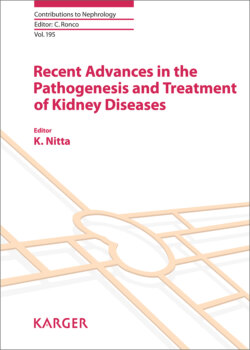Читать книгу Recent Advances in the Pathogenesis and Treatment of Kidney Diseases - Группа авторов - Страница 15
На сайте Литреса книга снята с продажи.
New Intracellular Trafficking Pathway of Albumin through Glomerular Endothelial and Epithelial Cells
ОглавлениеThe glomerular capillary wall is composed of glomerular epithelial cells, glomerular basement membrane (GBM), and glomerular endothelial cells. Glomerular endothelial cells comprise the innermost layer and connect to capillary lumen; glomerular epithelial cells comprise the outermost layer and connect to Bowman’s space; and GBM is located between the glomerular endothelial and epithelial cells. These three components serve as the glomerular filtration barrier to form a crude urine filtrate from blood. Traditionally, in glomerular endothelial cells, albumin particles pass through fenestrae that are 100 nm in size and lack a diaphragm, while in glomerular epithelial cells, albumin passes through a slit diaphragm located in the gap between podocyte foot processes (Fig. 2a). However, in several kinds of primary and secondary glomerulonephritis, glomerular endothelial cells become swollen, causing the fenestrae to narrow and the foot processes of glomerular epithelial cells to fuse; this fusion results in the loss of the gap between foot process (Fig. 2b). In this situation, the caveolae pathway is repurposed to serve as an alternative albumin pathway across glomerular endothelial and epithelial cells. In glomerular endothelial cells, albumin particles enter through caveolae using an unknown receptor, move freely and not in conjunction with cytoskeletal structures (e.g., actin and microtubules), and arrive at early endosomes. In early endosomes, these albumin particles are able to bypass typical endosome-associated organelles (e.g., GA and ER) without undergoing modifications, such as glycosylation, proteolytic processing, sulfation or phosphorylation; the albumin particles also bypass the lysosome and proteasome without undergoing degradation and are transported directly to the other side of the cells for ultimate excretion (Fig. 3).
After passage through GBM, albumin particles enter glomerular epithelial cells through FcRn present in caveolae, then move along cytoskeletal components (e.g., actin) and arrive at early endosomes. In early endosomes, some albumin particles are sorted for degradation by lysosomes or may induce cell apoptosis through cytokine activation; however, other albumin particles are transported to Bowman’s space. In the experimental diabetic nephritis mouse model, MBCD treatment decreased albuminuria, without effects on blood glucose, body weight, or kidney weight. Moreover, MBCD treatment did not affect glomerular deterioration, demonstrated by the measurement of glomerular and mesangial surface area [31]. Combined with our reports that MBCD treatment decreases Cav-1 expression on glomerular capillaries and decreases albuminuria in the PAN-induced nephrotic syndrome mouse model, these data indicate that the caveolae pathway in both glomerular endothelial and epithelial cells may provide an additional etiology for albuminuria along with the classical fenestral pathway in glomerular endothelial cells and the slit membrane pathway in glomerular epithelial cells.
Fig. 2. Passage of albumin particles through glomerular capillary. a In the normal kidney, few albumin particles pass through fenestra in the glomerular endothelial cells, through glomerular basement membrane, then through the slit membrane in the gap between foot processes of glomerular epithelial cells. b In glomerulonephritis, fenestrae in the glomerular endothelial cells are narrowed and gaps between foot processes in glomerular epithelial cells are fused. In this situation, albumin may pass through glomerular endothelial and epithelial cells by caveolae-dependent pathways.
Fig. 3. Albumin endocytosis, transcytosis, and exocytosis through glomerular endothelial cells. After albumin particles (yellow) are captured in caveolae, caveolae are pinched off from cell membrane. Albumin particles in the caveolae-coated pit move independently from the cytoskeleton and arrive at early endosomes. Albumin particles are then sorted to the other side of cell membrane for exocytosis and avoid degradation by any of the following: proteasome, lysosome, Golgi apparatus, or endoplasmic reticulum.
